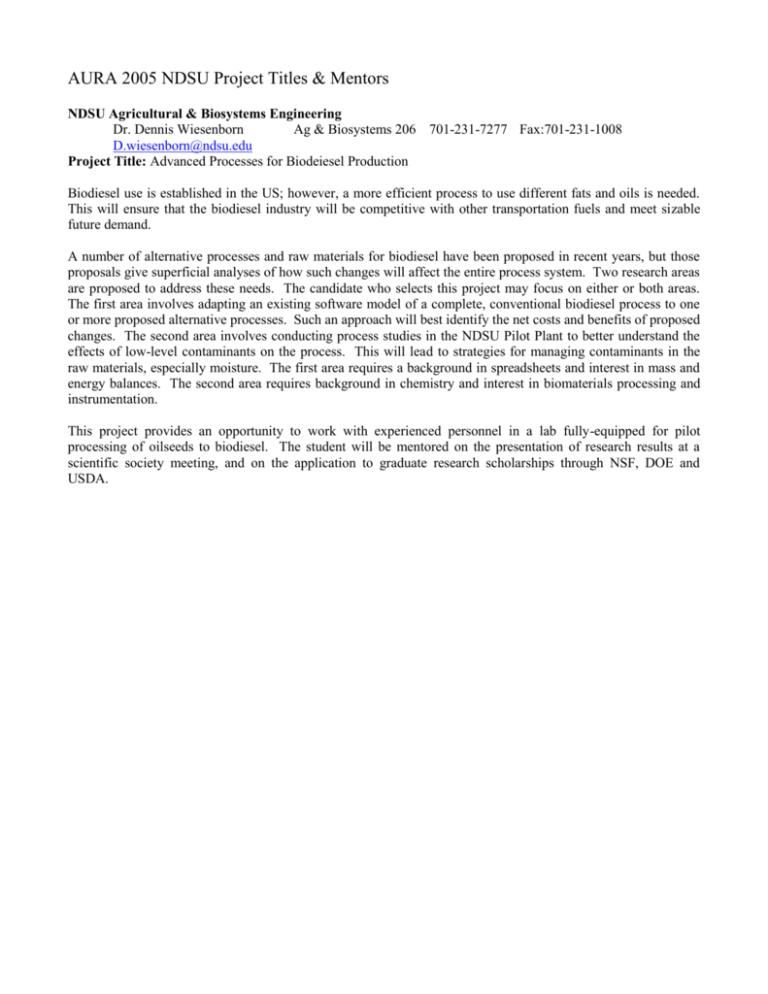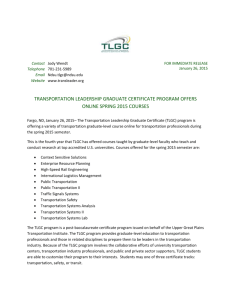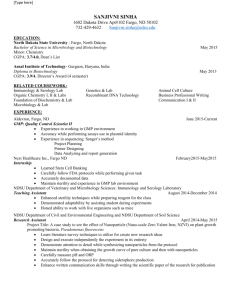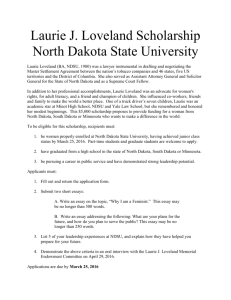NDSU Chemistry - North Dakota State University
advertisement

AURA 2005 NDSU Project Titles & Mentors NDSU Agricultural & Biosystems Engineering Dr. Dennis Wiesenborn Ag & Biosystems 206 701-231-7277 Fax:701-231-1008 D.wiesenborn@ndsu.edu Project Title: Advanced Processes for Biodeiesel Production Biodiesel use is established in the US; however, a more efficient process to use different fats and oils is needed. This will ensure that the biodiesel industry will be competitive with other transportation fuels and meet sizable future demand. A number of alternative processes and raw materials for biodiesel have been proposed in recent years, but those proposals give superficial analyses of how such changes will affect the entire process system. Two research areas are proposed to address these needs. The candidate who selects this project may focus on either or both areas. The first area involves adapting an existing software model of a complete, conventional biodiesel process to one or more proposed alternative processes. Such an approach will best identify the net costs and benefits of proposed changes. The second area involves conducting process studies in the NDSU Pilot Plant to better understand the effects of low-level contaminants on the process. This will lead to strategies for managing contaminants in the raw materials, especially moisture. The first area requires a background in spreadsheets and interest in mass and energy balances. The second area requires background in chemistry and interest in biomaterials processing and instrumentation. This project provides an opportunity to work with experienced personnel in a lab fully-equipped for pilot processing of oilseeds to biodiesel. The student will be mentored on the presentation of research results at a scientific society meeting, and on the application to graduate research scholarships through NSF, DOE and USDA. NDSU Animal and Range Sciences Dr. Sarah Wagner 101 Robinson Hall Sarah.Wagner@ndsu.edu Project Titles: 701-231-5393 Fax: 701-231-7514 1) The Effect of Delayed Antibiotic Therapy or No Antibiotic Therapy in a Clinical Mastitis Culturing and Treatment Program By withholding treatment of bovine clinical mastitis for 24 hours following diagnosis until preliminary microbial culture results are obtained, fewer cows are treated with antimicrobial drugs. Fifty percent or more of the microbial cultures in such a program may yield no microbial growth and cows with such results are not treated. Objective 1: To determine whether a 24-hour delay in beginning treatment of clinical mastitis depresses clinical and bacterial cure rates when compared with immediate treatment. Objective 2: To evaluate how well laboratory findings of microbial susceptibility or resistance correlate with therapeutic successes and failures. This study is being conducted on commercial dairy farms in South Dakota and Michigan. Following diagnosis of mastitis, a milk sample is taken from each affected quarter and used to start a bacterial culture. Cows are randomly assigned to one of two groups. Cows in Group A begin treatment with intramammary antibiotic immediately following diagnosis of mastitis and milk sampling. Cows in Group B are treated with intramammary antibiotic only if they have microbial growth on their milk culture after 24 hours incubation. Culture results are recorded for both treatment groups. Outcomes including clinical cure, microbiological cure, and subsequent illness will be compared between the two treatment groups. Bacterial isolates from mastitis cases treated with antibiotics will be submitted to a diagnostic laboratory for susceptibility testing, and the results will be evaluated for their correlation with therapeutic outcomes. 2) Variability of Fever and Inflammation in Postpartum Dairy Cows It has become a common practice to monitor rectal temperatures of dairy cows once daily for the week following calving, with action taken if temperature rises above a certain breakpoint. Most commonly, the action taken in response to elevated temperature is treatment with antimicrobial drugs. Currently used breakpoints for action may be inappropriately low, with the result that antimicrobial drugs are administered more often than necessary. NDSU Biological Sciences Dr. Mary Stewart, Stevens Hall, Room 317 701-231-8226 Fax: 701-231-7149 Mary.Stewart@ndsu.edu Project Title: Undergraduate Research to Characterize a Novel Growth Regulator in the STE-20 Kinase Family Cell growth is the accumulation of mass, a process required for cell division. While driving growth is important, halting growth is equally important since unregulated growth can drive cell division, a process implicated in cancers. We have carried out a genetic screen in Drosophila melanogaster (the fruit fly) for novel genes that regulate tissue growth. We identified a lines of flies that we hypothesize overexpress a STE-20 protein kinase family member. These flies show phenotypes that indicate tissue growth has been inhibited, suggesting that the normal role of the kinase is to halt cell growth or division. This kinase is conserved in humans, but is not well characterized in humans and not characterized at all in Drosophila. Our first aim is to test that the kinase is expressed at higher than normal levels in the flies in which we have observed phenotypes. This will be met by Northern blot analysis. The second aim is generate loss-of-function alleles of the kinase. To do so, we will mobilize a transposon that is inserted near the STE-20 kinase gene with the goal of causing small deficiencies that delete the gene. This project will allow a student to do independent, but mentored, research as well as to work in a team environment and participate in paper discussions that focus on the theme of growth regulation. NDSU Biological Sciences Dr. Wendy L. Reed Stevens Hall 311 701-231-5921 Fax: 701-231-7149 Wendy.Reed@ndsu.edu Jennifer Newbrey (Ph.D. candidate) Field / Laboratory Specialist: Stevens Hall 311 Phone: (701) 231-5902 Fax: (701) 231-7149 Project Title: Tradeoffs between Reproduction and Sexual Signals in Three Species of North Dakota Blackbirds. To help us to gain a better understanding of how resource tradeoffs between sexual signals and reproduction can influence chick performance, an AURA student will collect eggs of three species of central North Dakota blackbirds, yellow-headed blackbirds (Xanthocepahlus xanthocephalus), red-winged blackbirds (Agelaius phoeniceus), and common grackles (Quiscalus quiscula). All three species of blackbirds allocate carotenoids (i.e., biologically-active red and yellow pigments) to their egg yolks. However, they have variable amounts of carotenoid-based plumage; female yellow-headed blackbirds have large patches of yellow feathers, female redwinged blackbirds have only small patches of red feathers, and female grackles do not have carotenoid-pigmented feathers. Carotenoids protect developing embryos against DNA, protein, and lipid damage. They are also incorporated into the sexual signals of many adult birds and are thought to honestly reflect individual quality. Through becoming involved with this research project, an AURA student will learn valuable skills in developing, implementing, data analyzing, writing, and presenting the results of a research project. They will assist with both field data collection and laboratory analysis and will acquire skills in nest searching, nest monitoring, trapping and banding, egg and bird handling, and carotenoid extraction and quantification. Our ongoing research has focused solely on yellow-headed blackbird reproductive biology. The data gathered by the AURA student will help to augment our research by allowing us to further explore carotenoid tradeoffs between sexual signals and reproduction in multiple species of blackbirds. NDSU Biological Sciences Dr. Mark A. Sheridan, James A. Meier Prof. Rm 236, Research I 701-231-8110 Fax: 231-7149 mark.sheridan@ndsu.edu Project Title: Hormonal control of animal growth, development, and metabolism This project will enable an undergraduate student to participate in my ongoing research program on the hormonal control of animal growth, development, and metabolism. The student will be immersed in an active research environment where they will engage in team and individual research projects, attend local, regional and /or national scientific meetings, and interact with various visiting scientists which my lab will host. The participant will be exposed to the entire research process, including hypothesis formulation and experimental design, experimental and analytical procedures, data analysis and interpretation, and preparation of data for presentation and publication. They will become familiar with basic and advanced laboratory methods, with special attention to recombinant DNA technology. Specifically, they will assist with 1) isolation, cloning and sequencing of hormone receptors, 2) establishing the pattern of receptor expression, and 3) evaluating the mechanisms that serve to regulate receptor expression. The student’s involvement will enhance their own personal and professional development as well as increase the productivity of my research program and allow us to pursue promising avenues of inquiry not otherwise possible. The student will gain a sense of the research process and be exposed to a greater diversity of ideas and role models than they would normally experience, thereby expanding the vision of their career options. NDSU Chemistry & Molecular Biology Dr. Uwe Burghaus 202 Ladd-Dunbar 701-231-9742 Fax 701-231-8831 Email uwe.burghaus@ndsu.nodak.edu URL http://www.chem.ndsu.nodak.edu Project Title: Molecular Beam Scattering on Metal Oxide Surfaces The proposed project is related to a subtopic of physical chemistry. An experimental study about a metal oxide surface will be conducted by means of a molecular beam scattering apparatus; i.e., we would work on a surface chemistry (heterogeneous catalysis) problem of current interest. One of the ultimate goals in surface chemistry is to draw a relationship between the structure and reactivity of catalysts surfaces. The Structure-Activity Relationship (SAR), is well established in organic and biological chemistry. Based on these relationships, fundamental rules and guiding principles have been set up, which may develop into the mainstay of drug design in the pharmaceutical industry. By way of contrast, so far only a few such rules exist in the area of surface science. As a first step in gaining a deeper understanding about SAR for a surface, we will characterize the (1x1)TiO2(100) to (1x3)-TiO2(100) face transition. Thus, we will look at two surfaces which are made of the same material, TiO2, but have a very different atomic structure. In doing so, molecular beam scattering techniques will be applied. A molecular beam might be compared with a LASER system; however, instead of monochromatic light, we use supersonic and nearly monochromatic particle beams, which allow us to sample the structure and reactivity of surfaces. Results about SAR have recently been published together with undergraduate coauthors (J. Wang, B. Hokkanen, U. Burghaus, Surface Science in press; The SAR in The Case of Cu/Zn-ZnO, J. Wang, E. Johnson, U. Burghaus, submitted.) NDSU Chemistry & Molecular Biology Dr. Sanku Mallik Ladd-Dunbar 104G 701-231-8829 Fax:701-231-8831 Sanku.Mallik@ndsu.edu D. K. Srivastava Ind Ag Comm Ctr 312 701-231-7831 Fax:701-231-8831 DK.Srivastava@ndsu.edu Project Title: Triggered Release of Liposomal Contents by Gelatinases Abstract: The matrix metalloproteinases are produced at elevated levels by a variety of malignant tumors. In the proposed studies, a general targeting and release methodology from hybrid liposomes will be developed, mediated by peptides. The idea is to incorporate short chain peptides, which are specifically recognized and cleaved by the gelatinases, resulting in the destabilization of the liposomes and releasing the content in the vicinity of the enzymes. If the liposomes are formulated with entrapped enzyme’s inhibitor, the enzyme assisted “uncorking” process will result in its “suicidal” inhibition. In addition, inhibitors for other enzymes, imaging agents and drugs can be released employing this proposed methodology. During the proposed studies, gelatinase-A and -B will be used as the model enzyme. Specifically, the objectives of this proposal are: (1) to synthesize different types of saturated lipid – peptide conjugates containing the cleavage site for the gelatinases; (2) to optimize the liposome composition and conditions for the UV-induced polymerization of the liposomes to produce the hybrid liposomes with the surface exposed peptides; (3) detailed mechanistic studies on the cleavage of the lipopeptides in solution as well as incorporated in liposomes; (4) to determine the molecular mechanism and the sequence of events leading to the release of the liposomal contents. These specific aims will be accomplished by employing the techniques of synthetic organic chemistry, fluorescence, CD, and NMR spectroscopy, molecular biology, and enzyme kinetics. NDSU Chemistry & Molecular Biology Dr. Sanku Mallik Ladd-Dunbar 104G 701-231-8829 Fax:701-231-8831 Sanku.Mallik@ndsu.edu D. K. Srivastava Ind Ag Comm Ctr 312 701-231-7831 Fax:701-231-8831 DK.Srivastava@ndsu.edu Project Title #2: Use of Surface-Binding Groups in Inhibitor Design Abstract: This proposal aims to develop high-affinity inhibitors for human carbonic anhydrases by employing metal-ligand interactions. A known inhibitor of the enzyme will be conjugated to a ligand capable of chelating a variety of transition metal ions. In the resultant conjugates, the inhibitor will bind to the active site and the metal ions will bind to surface-exposed histidine residues simultaneously. The binding energies of such “two prong” inhibitors will be derived from the interactions at both the active site as well as the protein surface (histidine residues); hence they are expected to be more potent than the conventional inhibitors (which are designed only for the binding within the active site regions). Since the surface exposed histidine patches are not conserved among carbonic anhydrase isozymes, our contemplated “two-prong” inhibitor design approach will produce isozymespecific inhibitors for carbonic anhydrases. The specific aims of this proposal can be summarized as follows. (1) Synthesize benzenesulfonamide organic chelate conjugates with various transition metal ions as potential inhibitors of carbonic anhydrases. (2) Determine the binding affinities of the two-prong inhibitors to selected carbonic anhydrase isozymes. (3) Probe the selectivity of the two-prong inhibitors for the binding at the surface confined histidine residues of selected carbonic anhydrase isozymes. (4) Delineate the sequence of events and the energetic contributions for the stabilizations of the two-prong inhibitors to different carbonic anhydrase isozymes. These aims will be accomplished by employing the techniques of synthetic organic chemistry, molecular biology, electronic spectroscopy, steady-state and transient kinetics, isothermal titration microcalorimetry, and molecular modeling. NDSU Chemistry and Molecular Biology Dr. Mukund P. Sibi, Jordan A, Engberg Professor Ladd Dunbar 354A 701-231-8251 Fax:701-231-1057 Mukund.Sibi@ndsu.edu UND Chemistry Dr. Anamitro Banerjee. AH 224-F, Box 9024 701-777-3941 Fax: 701-777-2331 abanerjee@chem.und.edu Project Title: A Two-pronged Approach to Undergraduate Research Training in Catalysis Abstract: Catalysis is pervasive in society. It spans such disparate areas as converters for cars to methods for the preparation of pharmaceuticals. From a chemical perspective, development of highly efficient eco-friendly methods for the preparation of pharmaceuticals, polymers, day to day chemicals, materials, etc, is of high significance. In this proposed research program, the undergraduate researcher will participate in two different laboratories and learn diverse aspect of catalysis. We have identified a highly qualified student from UND, Carol Wright, who will participate in a summer program under the guidance of Prof. Sibi. The student will learn different aspects of chiral Lewis acid catalysis, a premiere method for the enantioselective construction of C-C bonds, during her summer internship. In particular, she will investigate details of [3+2] cycloaddition of -unsaturated acceptors. This transformation provides ready access to enantioenriched pyrazoles, a common scaffold present in therapeutic agents. Carol will be a senior undergraduate at UND in Fall 2005. She will continue her undergraduate research in the laboratory of Prof. Banerjee in Fall 2005 and reinforce her learning from the summer program. She will carry out the synthesis of ethylenediaminetetracetic acid (EDTA) analogs that will polymerize in the presence of metal cations. We expect these polymers to be soluble in aqueous media as a random coil, and dissolve in organic solvent as a helix with a hydrophilic inner core and hydrophobic exterior. As a result, these polymers will be able to function as phase transfer catalysts: carry ionic compounds to the organic solvent and help it react with water insoluble organic compounds. NDSU Civil & Industrial Engineering Dr. Valery Marinov 202L Civil & Ind Engr Bldg Valery.marinov@ndsu.edu Project Title: Power Sources for Printed Microelectronics 701-231-8073; 5353 Fax: 701-231-7195 Printed electronics is a new and rapidly expanding branch of electronics manufacturing and electronics material science, which develops and applies organics and inorganic materials or material systems to create discrete components, systems, or entire devices by means of material additive technologies such as screen printing, ink-jet printing, or direct-write methods. One of the major advantages of this technology is its capability to efficiently produce directly onto flexible substrates low-cost disposable microelectronic devises (RFID tags, microsensors, etc.) with commercial, defense, and homeland security usage and markets estimated in trillions. The advancements in printed electronics are significant, especially in the fabrication of interconnects and passive components (resistors, capacitors, inductors) or active semiconductor devices (organic transistors and lightemitting diodes) yet the question of how to power the printed devices with correspondingly small and inexpensive power sources remains. In fact, the small-scale and cheap power supply is probably the single biggest obstacle to the widespread implementation of the printed electronics. The power source must be cheap and small, and suitable for mass production on inexpensive organic substrates by low-cost technologies. The objective of this project is to study the feasibility of developing a printed battery employing the direct-write material deposition technology currently available at NDSU. The major project tasks include a study and selection of a few battery chemistries suitable for the direct-write method of fabrication, development of an innovative battery design to take a full advantage of the direct-write approach, and fabrication and characterization of a prototype battery printed on a flexible substrate. Project Title: Use of Surface-Binding Groups in Inhibitor Design Abstract: This proposal aims to develop high-affinity inhibitors for human carbonic anhydrases by employing metal-ligand interactions. A known inhibitor of the enzyme will be conjugated to a ligand capable of chelating a variety of transition metal ions. In the resultant conjugates, the inhibitor will bind to the active site and the metal ions will bind to surface-exposed histidine residues simultaneously. The binding energies of such “two prong” inhibitors will be derived from the interactions at both the active site as well as the protein surface (histidine residues); hence they are expected to be more potent than the conventional inhibitors (which are designed only for the binding within the active site regions). Since the surface exposed histidine patches are not conserved among carbonic anhydrase isozymes, our contemplated “two-prong” inhibitor design approach will produce isozymespecific inhibitors for carbonic anhydrases. NDSU Computer Science Dr. Dianxiang Xu 258 A25 IACC dianxiang.xu@ndsu.edu Project Title: Testing Aspect-Oriented Software 701-231-8185 Fax: 701-231-8255 Defects and failures persist in computer software due to the increasing complexity. Aspect-oriented computer programs as an emerging computing paradigm are no exception. In fact, they suffer from more bug hazards due to the introduction of new programming constructs. The objective of this research is to develop a method for generating test cases that can adequately test aspect-oriented software, particularly AspectJ programs. The tasks include: 1) developing an approach for aspect-oriented modeling, 2) designing and implementing a model-based test generation algorithm for testing AspectJ programs and revealing bugs that likely occur in AspectJ programs, and 3) evaluating the performance of the test generation method for testing AspectJ programs. The student will participate in implementing and evaluating the test generation method for testing aspect-oriented programs. During the research, the student will also learn about basic concepts and advanced topics of software testing and aspect-oriented programming. In addition, the student will have an opportunity to attend a most prestigious international conference on software engineering. The research will not only result in a grant proposal to NSF, but also inspire the student to pursuit advanced degrees and to develop interest in a research career. After entering graduate program, the student is expected to submit an application for graduate fellowship to national funding agency. NDSU Geosciences Dr. Kenneth Lepper 218 Stevens Hall 701-231-6746 Fax: 701-231-7149 Ken.Lepper@ndsu.edu Dr. Allan Ashworth 218 Stevens Hall 701-231-6746 Fax: 701-231-7149 Allan.Ashworth@ndsu.edu NDSU Biology Mr. Michael Newbrey 218 Stevens 701-231-7654 Fax:701-231-7149 Michael.newbrey@ndsu.edu Project Title: Age and Paleoecology of an Ice Age Fossil Site in South Dakota The Great Plains has experienced numerous climatic shifts during the last one to two million years. At times the climate was as warm as the present day; at other times the climate was cold with major glacial advances. Fossils deposited during these times record the effects of climate change on the evolution and distribution of modern organisms. An exceptional fossil site near Ree Heights, South Dakota, was discovered in 1891 that preserves the remains of fishes and terrestrial plants. The fossil fish species are the same as those inhabiting the Great Plains today, which suggests that they lived during a warm interglacial. The geologic age of the lake deposits is not known. This study, utilizing OSL dating techniques, should provide badly needed age information for the lake deposits at the site. The work will provide research opportunities to two undergraduate students, who will work on separate aspects of the study as part of a five-member research team. One student will process sediment samples to age-date the site, while the other will identify fossils to make inferences about paleoclimate. Linkage of the chronological and paleontological aspects of the study will enable response rates of organisms to climate change to be analyzed. The students will learn practical research skills and gain valuable experience to enhance their careers. They will each present their results at a scientific meeting. Their contributions will provide new insight into an important fossil locality on the Great Plains. NDSU Industrial and Manufacturing Engineering Dr. Om Prakash Yadav 202 Civil/Ind Engr Bldg Om.Yadav@ndsu.edu 701-231-7285 Fax: 701-231-7195 Project Title: Integrating Six Sigma Methods and Lean Principles in Health Care Environment This project proposes the integration of well-established principles of lean philosophy and Six-Sigma methodology in health care environment. Reducing waste has been the prime focus of lean principles in order to minimize the resource requirement (such as time, people, money, etc.), while Six Sigma methodology addresses variation around the average target or goal. The customer’s focus is not so much on waste elimination or variation reduction, but on actual time and cost incurred in getting the service delivery. In many scenarios, however, low variation is much more crucial to the customer satisfaction than a low average time. However, to only focus on variation reduction in the presence of non-value adding activities will not result into significant improvement. Another major concern is that these approaches have been confined to manufacturing plants. One can find very few cases where these approaches have been applied to other sectors. The reasons could be that these methods are developed and finely tuned to the context of discrete manufacturing, their reliance on manufacturing based tools and metrics, and the difficulty of defining comparable approaches and metrics for non-manufacturing sectors. Drawing on the recent work suggesting integration of these approaches to achieve comprehensive improvement in customer satisfaction, the project proposes to address the following questions: (1) Can the principles of the lean and Six Sigma approaches improve health care performance? (2) If so, is it possible to integrate these two tools in health care environment to achieve continuous improvement in customer satisfaction? (3) What implementation strategies are more likely to lead to success? Based on the answers to these questions, the research will develop new set of principles, tools, and metrics to help health care system nationwide improve through integration of SixSigma and lean principles. The health care system in North Dakota presents a unique opportunity to study the health care delivery system to identify waste – non-value adding tasks -- and impact of health care delivery variation. Merit Care has agreed to support the research efforts by allowing principal investigator and student to study and investigate the existing health care delivery process. This project holds great promise for significant and lasting theoretical and practical outcomes, both through expanding knowledge of manufacturing system in health care sector and integrating two well established approaches emphasizing comprehensive improvement. NDSU Pharmaceutical Sciences Dr. Bin Guo 11 Sudro Hall 701-231-5164 Fax: 701-231-8333 Bin.Guo@ndsu.edu Project title: A Novel Small Molecule XIAP Inhibitor for Treatment of Breast Cancer. The Inhibitor of Apoptosis Proteins (IAPs) inhibit caspases that execute the cell death program. Among the eight human IAPs, X chromosome-encoded IAP (XIAP) is the most potent caspase inhibitor. XIAP is frequently overexpressed in human breast cancers and contributes to cancer cell survival. A novel small molecule XIAP inhibitor has recently been identified to induce apoptosis in various cancer cell lines and inhibit in vivo growth of prostate and colon tumor xenografts. This project aims to evaluate the therapeutic efficacy of this XIAP inhibitor in a mouse model of breast cancer. The specific aims of this project are: 1) To examine the pro-apoptotic activity of the XIAP inhibitor in cultured breast cancer cells; 2) To determine the therapeutic efficacy of the XIAP inhibitor as a single agent in transgenic mice carrying breast tumor; 3) To determine the therapeutic efficacy of the XIAP inhibitor in combination with chemotherapeutic drugs. If successful, this novel inhibitor can be further evaluated clinically as a single agent or in combination with chemotherapy for breast cancer. NDSU Pharmaceutical Sciences Dr. Anne Hinderliter 116B Sudro Hall 701-231-6556 Fax: 701-231-8333 Anne.Hinderliter@ndsu.edu Project Title: A novel mechanism in regulation of cellular signaling, protein-induced lipid domain formation. The overall ongoing hypothesis is that C2 domains and annexins, which bind the lipid phosphatidylserine, induce formation of membrane domains and stems from the viewpoint of membrane biophysics. Specifically, that an enormous lipid variety exists in eukaryotic membranes to provide an on and off switch for signaling events at the membrane. Small changes in lipid chemical structure such as increasing the length of an acyl chain by a methylene group, changes the small cooperative interactions that exists between lipids. A favorable interaction of a protein with certain lipids induces accumulation of those lipids in the neighborhood of the protein. Through nearest neighbor interactions between lipids, these small changes ripple outward. The change in local composition of lipids is sensed by other proteins, which are recruited to the lipid domain and will induce further reshuffling. We suggest that within the family of proteins called the annexins and with proteins containing C2 domains, small changes in the protein chemical structure of each of these proteins leads to binding to and organizing specific membrane domains. The unique membrane-protein interactions provided by these proteins we suggest are coupled to the lipid-lipid interactions that are specific to each lipid mixture. Both aspects of the question, protein and lipid chemical structure and how one influences the other, must be welldeveloped to fully test the hypothesis. We approach the questions raised with a statistical thermodynamic viewpoint based on molecular biology, spectroscopic, and computational techniques. NDSU Pharmaceutical Sciences Dr. Jonathan J. Sheng Sudro Hall 35 jonathan.sheng@ndsu.edu 701-231-6140 Fax: 701-231-8333 Undergraduate Student: Karan Herman, Undergraduate Major: Pre-pharmacy karan.e.herman@ndsu.edu Project Title: Structure/Function Studies on Hydroxysteroid Sulfotransferase Hydroxysteroid sulfotransferase is one of the major hepatic sulfotransferase isoforms, and it catalyzes the sulfation reactions of both endogenous chemicals such as steroids and xenobiotics such as benzylic alcohols. Many substrates of hydroxysteroid sulfotransferase are related to human carcinogenicity. The long-term objective of this project is to study the pharmacological roles of hydroxysteroid sulfotransferase in humans as well as in rodents that contribute to human risk assessment toward steroid-derivative drugs and chemical carcinogens. It will emphasize the structure/activity relationships and interspecies variations in terms of substrate specificity, kinetic property, and cellular biological features of hydroxysteroid sulfotransferase. The working hypothesis is that there exist interspecies variations for hydroxysteroid sulfotransferase in that relate to specific differences in catalytic specificity and cellular biological feature. The specific aims are proposed to approach the interspecies variation between human and rodent isoforms in terms of catalytic activity, structure/function relationship, and cellular biological feature, and to assess the roles of hydroxysteroid sulfotransferase in the sulfation of endogenous steroids and selected exogenous carcinogens. Results from the currently proposed studies will enhance our understanding of the structure/function of hydroxysteroid sulfotransferase particularly relevant to cancer pathogenesis. NDSU Psychology Dr. James R. Council 105K Minard 701-231-7065 Fax: 701-231-8426 james.council@ndsu.edu Project Title: Creativity Enhancement Through Hypnosis: Effects of Gender-Specific Suggestions This project extends a program of research in which the PI has been collaborating with faculty in the visual and dramatic arts to develop hypnosis as a tool for enhancing artistic creativity. This topic is consistent with a major recent trend in clinical psychology known as positive psychology, which deemphasizes the field’s previous focus on treating psychopathology and other deficits, in order to focus on the enhancement of human potential and wellbeing. Funding for research on positive psychology is growing as a result of the American Psychological Association’s strong support. In this project, methods developed in previous research by the PI and collaborators will be tailored to enhance creativity in females. A large body of research has accumulated to show that females and males have basic differences in personality and creative styles. This project will first review the existing literature on differences in creative styles and creative productions in females vs. males. Based on these findings, the PI and student will write a literature review to be submitted to a scientific journal, and will devise an experimental study to test hypotheses derived from the literature review. The broad outlines of the proposed research will conform to the following logic. Our previous research, as well as anecdotal evidence, has shown not only that artists respond very positively to hypnotic treatments for creativity enhancement, but that these interventions have statistically significant results. The proposed research will tailor our general approach to develop interventions that should be maximally effective with females vs. male populations. NDSU Psychology Dr. Mark Nawrot 105L2 Minard Hall 701-231-8032 Fax: 701.231.8426 mark.nawrot@ndsu.edu Project Title: Eye movement interactions and the perception of depth from motion parallax Depth perception is crucial for quick and effortless locomotion through a cluttered and hazard-filled environment. However, information about the location of objects in our environment does not just appear to us automatically. Instead, our brain must interpret the changing patterns falling upon our retina. For instance, the relative movement between objects (produced by our own movement, like walking) gives us an important depth perception cue called motion parallax. Recent studies demonstrate that an extra-retinal eye movement signal made in response to observer translation is crucial for the unambiguous perception of depth from motion parallax. However, under some well-crafted conditions, such as motion pictures, a stationary observer perceives vivid and unambiguous depth from MP. It is unclear how the requisite extra-retinal signal might be generated in these stationary conditions, placing doubt on the central role of this extra-retinal signal in MP. The current study will determine if the extra-retinal signal serving MP is invoked by competition between two eye movement signals. One eye movement is reflexive, made in response to a broad field of background motion. The other eye movement (the one necessary for motion parallax) is voluntary and required to maintain fixation. Understanding these eye movement interactions is central to understanding how the brain uses retinal movement and internal eye movement signals for depth perception from motion parallax. NDSU Psychology Dr. Paul D. Rokke. Minard 115 V: 701-231-8626 F: 701-231-8426 Paul.Rokke@ndsu.edu Project Title: Emotional Influences on Attention: An Event Related Potentials Study The research to be conducted as part of this proposal is designed to investigate the influence of emotion on attention and to identify the underlying brain mechanisms associated with that influence. Event related potentials (ERPs) are voltage potentials generated by the cortex in response to a stimulus or response. These potentials can be recorded safely and easily by affixing electrodes to the surface of the heads of normal volunteers while they perform various tasks. Each stimulus or response results in a waveform with a series of peaks and valleys (called components) which reflect neurocognitive processing in response to the event in real-time. The real-time nature of ERP waveforms allows the researcher to measure the time-course of cognitive processing by examining the amplitude and latency of various components. We have previously found that when one is in a sad mood, attending to sad information interferes with ones ability to attend to subsequent information. Participants in this study will be induced into a sad mood and will complete a computerized attention task while their brain waves are being measured. This study will measure P3 latency (an ERP component that represents of the timing of stimulus encoding) to see whether the difficulty in identifying information following attention to a sad stimulus is associated with delayed encoding as represented by the P3 component. NDSU Veterinary & Microbilogical Sciences Dr. Birgit Pruess VanEs Lab 108A 701-231-7848 Birgit.Pruess@ndsu.edu Project Title: Mechanism of Aer mediated gene regulation Fax: 701-231-7514 In order to have effective therapeutic interventions to treat microbial infectious diseases, it is essential to thoroughly understand the survival strategies employed by pathogenic bacteria to enable them to persist in an infected host. The PI’s long-term goal is to understand the regulation of factors that contribute to virulence and pathogenicity in enteric bacteria. Of special interest is the response to signals from the host environment. In the past 10 years, the PI has developed a complex global regulatory network, involving several proteins that have been characterized as parts of the bacterial flagellum. One of these is the Escherichia coli Aer protein that has been characterized as a sensor to oxygen concentrations in the medium and in the cell. Its function in gene regulation is new. The genes that are regulated by Aer include many genes involved in anaerobic respiration. We believe that Aer is required for transitions from conditions of high oxygen to conditions of low oxygen. These would occur as bacteria living in the environment adapt to life in our intestines. As part of a project to determine the mechanism by which Aer might affect gene expression, we tried to determine the part of the Aer protein that is required for gene regulation. Unfortunately, this attempt had its limitations because of instability problems with the mutated Aer proteins. A continuation of these studies will involve the determination of conditions under which the bacteria express the amount of mutated Aer proteins that resembles the expression level of the wild-type Aer protein.









